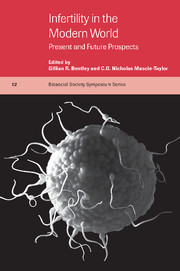Book contents
- Frontmatter
- Contents
- List of contributors
- 1 Introduction
- Part I Biomedical perspectives on fertility
- Part II Environmental influences on fertility
- 4 Environmental pollutants and fertility
- 5 From STD epidemics to AIDS: a socio-demographic and epidemiological perspective on sub-Saharan Africa
- Part III Social perspectives on infertility
- Index
4 - Environmental pollutants and fertility
Published online by Cambridge University Press: 13 January 2010
- Frontmatter
- Contents
- List of contributors
- 1 Introduction
- Part I Biomedical perspectives on fertility
- Part II Environmental influences on fertility
- 4 Environmental pollutants and fertility
- 5 From STD epidemics to AIDS: a socio-demographic and epidemiological perspective on sub-Saharan Africa
- Part III Social perspectives on infertility
- Index
Summary
Abstract
In the past decade, two popular science books, numerous articles and at least one television documentary have focused on environmental pollutants that are suggested to affect human reproductive potential. For example, xenoestrogens – substances present in many human-made products, such as plastics – have been linked to apparent dramatic declines in human sperm counts. They have also been blamed for recent increases in reproductive developmental abnormalities as well as rates of cancer of the reproductive tract. This chapter examines the relevant data as well as proponents' and critics' arguments for changes in male and female reproductive function and physiology in relation to manufactured environmental agents. In addressing these topics, the chapter takes an explicitly ecological approach to human fertility. It stresses the issue of natural variation both within and between human populations that may arise from a variety of environmental, genetic, temporal and even behavioural factors, and that may obscure our understanding of any single environmental factor suspected to affect human reproduction adversely. At present there is insufficient evidence to support the theory that environmental pollutants are primarily responsible for such adverse changes. We should, however, continue to monitor carefully the potentially harmful effects of these polluting agents.
Introduction
Beginning with the publication of Rachel Carson's silent spring in 1962, environmental pollution and its consequences for human health has become an issue of increasing public concern. Recently, however, the effects of chemical pollutants on reproductive health have made media headlines following a report published in 1992 by Danish scholars that human sperm counts had declined dramatically during the previous 50 years (Carlsen et al., 1992).
- Type
- Chapter
- Information
- Infertility in the Modern WorldPresent and Future Prospects, pp. 85 - 152Publisher: Cambridge University PressPrint publication year: 2000



